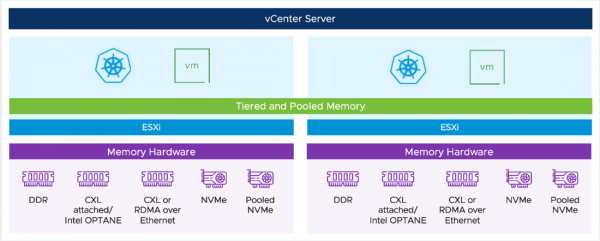VMware Introducing Project Capitola Software-Defined-Memory for Data Centric Workloads
Implementation that will aggregate tiers of different memories such as DRAM, PMEM, NVMe and other future technologies
This is a Press Release edited by StorageNewsletter.com on October 11, 2021 at 1:31 pmBy Dave Morera and Ragav Gopalan, cloud platform business unit, VMware, Inc.
Introducing Project Capitola: Software-defined-memory for data centric workloads
VMware announced Project Capitola as a technology preview.
It’s is a software-defined-memory implementation that will aggregate tiers of different memory types such as DRAM, PMEM, NVMe and other future technologies in a cost-effective manner, to deliver an uniform consumption model that is transparent to applications. With the growing need to process and consume amounts of data, the memory subsystem of the data center continues to be a bottleneck, impacting performance.
IDC points out a key trend that will shape and influence the design and architecture of future data centers – the Global DataSphere (amount of data generated globally) is expected to grow at a CAGR of 23% by 2024. (1)
As applications become increasingly memory bound, traditional scale up techniques result in higher overall infrastructure cost. In response to this challenge, infrastructures have started to build silos of heterogeneous memory tiers that offer varying performance-cost benefits. Often, these systems lead to a divergence in the memory consumption model resulting in the need for software changes in applications. This results in an unsustainable cost to meet the needs of business – both from an infrastructure as well as from an application development lifecycle perspective.
Enterprises are looking for cost-effective ways to seamlessly scale tiers of memory capacity on demand and with ease. They are looking for an unified infrastructure operating model across memory tiers. Application developers are looking for ways to consume a variety of heterogenous memory technologies in a homogeneous manner without the need to adopt specialized APIs.
This is where Project Capitola comes in.
The different tiers of memory technology are grouped into logical memory for easy consumption and managed in the backend by vSphere, increasing overall available memory in the tier that is required by the workload. Project Capitola allows for a lower TCO of memory by leveraging memory tiers at different price and performance points. Integration with ESXi memory management ensures that vSphere features such as Distributed Resource Scheduler (DRS) will work across new and existing memory tiers.
Project Capitola will be released in phases with the initial release focusing on tiering at the host level and subsequent releases extending capabilities to the cluster level. It preserves the existing day-0, -1 and -2 experience of provisioning, deploying and managing memory tiers within vSphere, that customers are familiar with. It will be enabled for on-premises data centers and the cloud by bringing together a broad ecosystem of memory vendors (e.g., Intel, Micron, Samsung), server designs (e.g., Dell, HPE, Lenovo, Cisco) and service providers (Equinix). In addition, VMware will collaborate with the ISV partner ecosystem and its product teams (e.g., Hazelcast, GemFire, Horizon VDI) to enable full stack solutions.
The company is collaborating with Intel as a leading partner to bring Project Capitola to the market based on Intel Corp.’ Optane PMem on Xeon platforms. Project Capitola is a step in the evolution of vSphere to meet the growing memory needs of the next gen of applications. Join us at VMworld 2021 to learn more about Project Capitola, featuring sessions by the firm and our industry leading partners.
-
[MCL2384] Big Memory – An industry perspective on customer pain points and potential Solutions
-
[MCL1453] Introducing VMware’s Project Capitola: unbounding the ‘Memory Bound’
Read here what partners are saying about Project Capitola!
(1) Data Creation and Replication Will Grow at a Faster Rate than Installed Storage Capacity, IDC Global DataSphere and StorageSphere Forecasts, March 24, 2021













 Subscribe to our free daily newsletter
Subscribe to our free daily newsletter
